We arrived at our beachside hotel on Phu Quoc Island where we had booked a bungalow with a sea view for the princely sum of US$20 per night. To get here involved turning off the dirt track that served as the island’s main north-south highway and down a 30-degree incline that scraped the underside of our taxi, before it became a simple bone shaking, head banging, short drive along a potholed cartway until the driver refused to go any further.
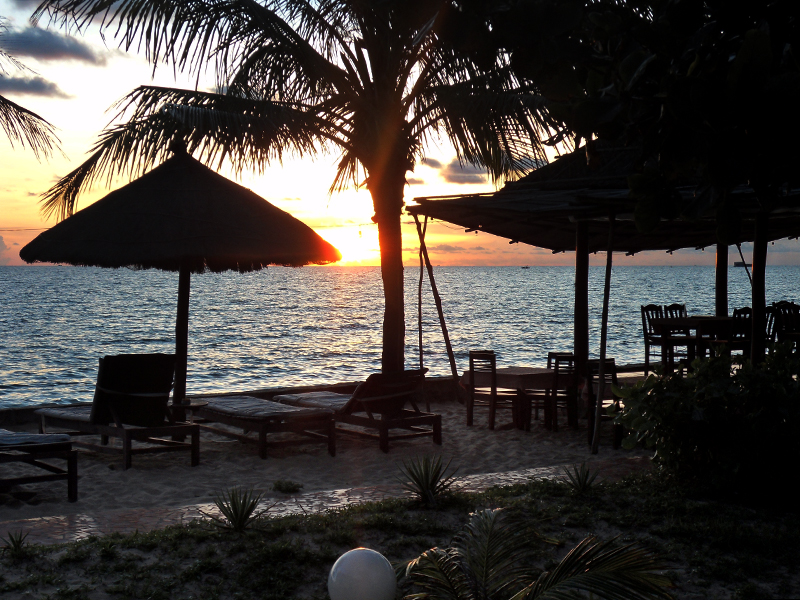 But the setting of the hostel was worth the uncomfortable journey. The sea splashed onto a golden beach only 15 metres from the reception/bar/dining/lounge area that had a roof made from palm leaves, held above ground by spindly dark wood and walls open to the elements. From our room, we could hear the rhythm of the sea as it fell exhausted upon the sand. The trees laden with thick green leaves rustled as the breeze bullied its way through the foliage. This seemed a perfect spot to end our time in Vietnam.
But the setting of the hostel was worth the uncomfortable journey. The sea splashed onto a golden beach only 15 metres from the reception/bar/dining/lounge area that had a roof made from palm leaves, held above ground by spindly dark wood and walls open to the elements. From our room, we could hear the rhythm of the sea as it fell exhausted upon the sand. The trees laden with thick green leaves rustled as the breeze bullied its way through the foliage. This seemed a perfect spot to end our time in Vietnam.
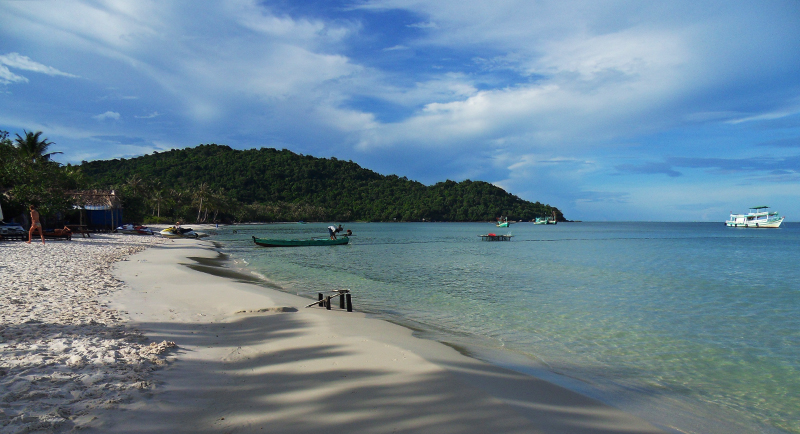 About 90% of Phu Quoc is protected forest. The mountainous northern half of the island consists of dense forest that is impenetrable to all but a few local guides. The rest of the island is made up of villages of varying size and deserted golden beaches. It is almost what a tropical island should be and, in this day and age, is as authentic as it gets. I suspect that the resort developers are already planning gargantuan concrete monoliths.
About 90% of Phu Quoc is protected forest. The mountainous northern half of the island consists of dense forest that is impenetrable to all but a few local guides. The rest of the island is made up of villages of varying size and deserted golden beaches. It is almost what a tropical island should be and, in this day and age, is as authentic as it gets. I suspect that the resort developers are already planning gargantuan concrete monoliths.
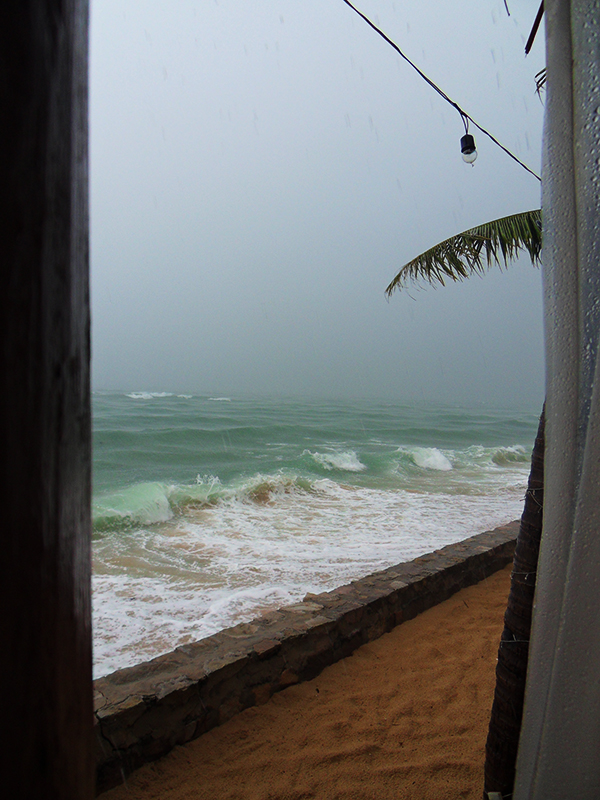 Soon after we arrived, we were treated to another aspect of tropical islands: torrential rain. It was as if we were under another waterfall as the rain fell out of cloud and drowned the land beneath. The wind lashed at everything above ground level in an uncontrollable rage, eventually managing to rip part of the roof off the bar/dining area. It was the type of rain that soaks to the skin within 5 seconds. Not that we would have noticed as we would be too busy concentrating on remaining upright.
Soon after we arrived, we were treated to another aspect of tropical islands: torrential rain. It was as if we were under another waterfall as the rain fell out of cloud and drowned the land beneath. The wind lashed at everything above ground level in an uncontrollable rage, eventually managing to rip part of the roof off the bar/dining area. It was the type of rain that soaks to the skin within 5 seconds. Not that we would have noticed as we would be too busy concentrating on remaining upright.
It continued raining all day and most of the night albeit at considerably less intensity and we began to wonder whether we would see the sun again during our short stay.
The following morning it was still cloudy in the way that promises more rain but we had booked ourselves a two-tank scuba dive so we were going to get wet anyway. To get to the dive boat involved a slow journey using what passes for road in this place. Wet, red-coloured mud, pockmarked with potholes filled with dirty water. It took 30 minutes to go 20km. It was impossible to travel any quicker without injuring both the van and its occupants.
With a prayer of thanks to the Almighty for sparing our lives, we staggered from the van onto a beautiful beach on the south east corner of the island called Bai Sao. It was a huge semi circle of soft white sand that encircled a bay with flat, benevolent, shallow water and fringed with swaying palm trees. At the apex of the circle and hidden among the trees stood little restaurants and shops selling a myriad of small items crammed into every available space. It was so quiet and sleepy that not even the dogs bothered to greet our arrival.
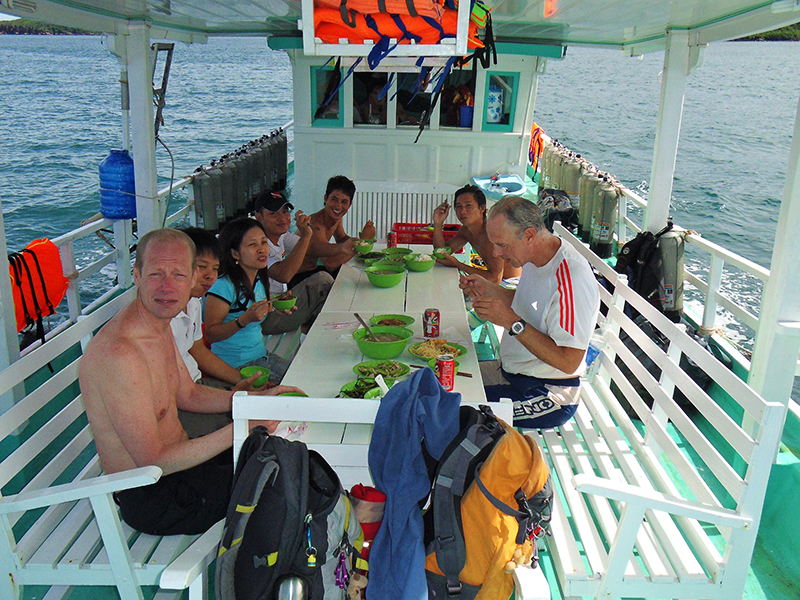 We clambered on to a tired old wooden boat that had many interesting seafaring tales behind it, and we set off at a suitably elderly pace towards our dive site. Ho, the divemaster in charge, told us that the boat had been made in England. A dubious claim given its layout. It had an outside kitchen at the stern of the boat, a loo that encroached the kitchen area, an engine that had to be started with a handle, a wheelhouse without any glass in the windows and nowhere that could be considered weatherproof. It was quintessentially Asian.
We clambered on to a tired old wooden boat that had many interesting seafaring tales behind it, and we set off at a suitably elderly pace towards our dive site. Ho, the divemaster in charge, told us that the boat had been made in England. A dubious claim given its layout. It had an outside kitchen at the stern of the boat, a loo that encroached the kitchen area, an engine that had to be started with a handle, a wheelhouse without any glass in the windows and nowhere that could be considered weatherproof. It was quintessentially Asian.
Arriving at the An Thoi Islands, a collection of 15 small bumps off the southern tip of Phu Quoc, we donned our gear and jumped into the sea. My dive computer told me that the sea temperature was 32c, the warmest waters in which we have explored. There was no need to wear a wetsuit here other than for protection against the multitudinous sea urchins that can spike the unwary all too easily.
The fish life was noticeable by its absence – there was nothing swimming around bigger than the palm of my hand. The local fishermen have ripped anything of any size from the sea and, in their increasing desperation to ensnare fish, are slowly destroying the coral. In this regard, Phu Quoc is following in the footsteps of Nha Trang further north along the coast, where the number of dive sites has been reduced from 20 to 4 by fishermen who have recklessly and systematically destroyed the coral with nets and dynamite. The only fish we saw on either of our dives that was of any interest was a bamboo shark, and that was dead!
Such destruction in this area would be tragic because the coral is stunning. The array of bright yellow, deep blue, purple and red hard and soft coral provides a riot of colour against the drab grey rock and dull sandy floor. Some of the corals are so large that they carpet large areas of rock providing an astonishing vibrancy and vitality of living organism that we have not encountered anywhere else. With so much coral of different colours and of different shapes and sizes it was like floating in one of those professionally maintained gardens that are open to the public. We had not expected such a wonderful display of nature’s talent and we enjoyed ourselves enormously.
After several more bouts of rain and a good night’s sleep we decided to spend the next day exploring the north of the island. I purloined an automatic motorbike from one of the staff for the budget-busting sum of US$4 and petrol. Actually, this was quite expensive compared to the hire costs elsewhere, but it saved us a two-way taxi drive to the nearest bike hire shop, so I readily agreed.
The bonus was that the bike handled much better than the run-of-the-mill stuff from hire shops and it came with a helmet that actually fitted my big head. So we set off along the unmade roads heading for Cua Can on the north west beaches of the island, about 28km away. We soon found that the state of the roads was so poor that progress was painfully slow and uncomfortable. We managed all of 20km per hour as we weaved around potholes and bumped along ridges on a surface that was still soft and squidgy after all the rain. Eventually, after 30 minutes, we came across a section of road that was completely covered in mud and on which the tyres lost all grip. In a nanosecond we slid sideways, hit a pothole and landed heavily in the dirt with our legs under the bike. How did that happen? Although the surface was really poor, I never thought we would come off!
Covered in red clay, the parts of our bodies that stung told us where the injuries were. Nothing too bad, a few scrapes, the odd gouge, dented pride mostly. I picked up the bike and examined it for damage – nothing bent or broken, I suppose we were going too slowly to do much harm. Oddly, Debbie did not want to continue: she had enough of being bounced about and thrown in the mud. Biking was no longer the fun it had been on decent roads.
Returning to town, looking exactly like the crash victims we were, we found a petrol station where we could refill the tank and wash ourselves and the bike using a hose. Washing off the mud from injured limbs was more painful than the accident. Boy, it stung. Examining our injuries without the cloak of mud, we thought that there was a good chance we would live, so we went off in search of a canteen where we get a coffee.
We then had a short conversation about whether we should tell the owner what happened. The bike was undamaged and working fine. It was clean and full of petrol. Telling the tale would only make us feel stupid. We decided that we had better ‘fess up’.
As it happened, it was all academic anyway for who should we run into immediately upon our return but the lady who owned the bike. Seeing our mud covered clothes and bleeding limbs, the tale was told more eloquently than waving my hands and mimicking a fall. She fussed over her bike as any proud owner might, having lent her prize possession to an idiot. She pointed out a couple of frayed edges on the foot board that she obviously felt had not been there previously. She then jumped on the bike and rode off. I imagined she had gone to fetch her 300lb brother who would fill me in, but she returned with 3 sticking plasters to cover our injuries. What a nice girl!
Debbie spent the balance of the day being fussed over by three masseurs having her nails done, muscles manipulated and all that girlie stuff. I sat and watched with alarm as my right knee swelled to the size of a balloon. What’s going on there? I had no pain before and I could walk perfectly normally. Now I can’t bend my leg and have to walk up and down steps one at a time. I feel hard done by, the gods have conspired against me and I need a large gin and tonic.
I had not intended to leave Vietnam hobbling on one leg, feeling like a plonker. I suppose the country has defeated another dreadful imperialist invader. I shall have to switch to an economic strategy!

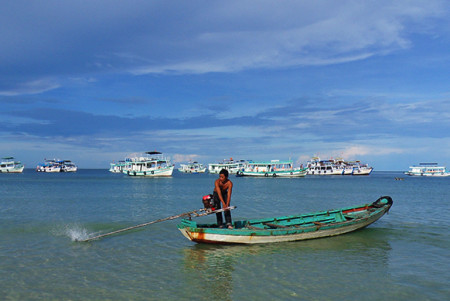
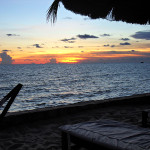
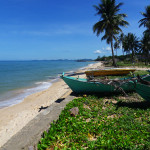
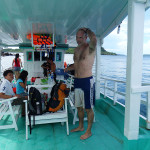
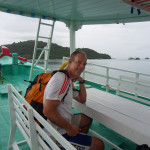
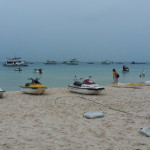
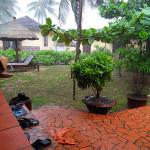
No comments yet.